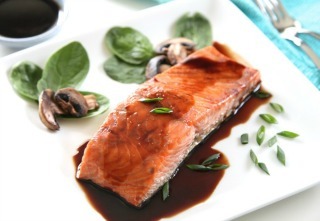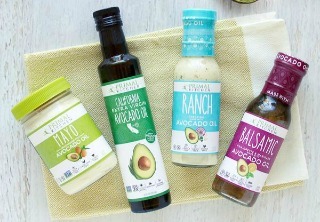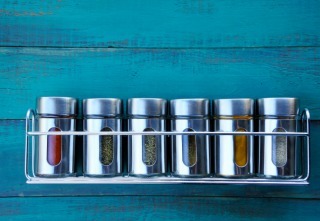Mark Sisson's Blog, page 153
February 13, 2018
Goodies Against the Grain: Sadie’s Story (and 2 Amazing Recipes) + IG Giveaway
 Today’s guest post is offered up by Sadie Radinsky, whom I had the pleasure of chatting with on a recent episode of her podcast, Jump For Joy. I think you’re going to love her story and be inspired by her success—in reclaiming her health and in following her passion. And the recipes she’s serving up? Grok never had it so good. Just in time for Valentine’s Day. Enjoy, everyone! And be sure to check out the giveaway at the end.
Today’s guest post is offered up by Sadie Radinsky, whom I had the pleasure of chatting with on a recent episode of her podcast, Jump For Joy. I think you’re going to love her story and be inspired by her success—in reclaiming her health and in following her passion. And the recipes she’s serving up? Grok never had it so good. Just in time for Valentine’s Day. Enjoy, everyone! And be sure to check out the giveaway at the end.
Hi, Mark’s Daily Apple! I’m Sadie, a 16-year-old food blogger, Paleo dessert chef and writer. I am so excited to share my health journey with you today, as well as two scrumptious Valentine’s Day treat recipes.
A little background about me: I grew up a vegetarian, with a diet that consisted mainly of whole grain products, beans, veggies, fruit, and the occasional fish. All of this would soon change because at the age of nine, I had to miss six months of school due to health issues. Every day I would wake up with intense stomach pain, fatigue and nausea. Most days it was hard to get out of bed. Pretty fun, right?
My parents knew something was wrong, but they just didn’t know what. My mom took me to countless Eastern and Western doctors, and still… no diagnosis. One day, she had the brilliant idea that I should go gluten-free for a little while and see how it made me feel.
Two months later, I was completely healed.
Food has an immense power on our bodies. As a nine-year-old, it was empowering to see how changing my diet made me a healthy and happy person, free from pain. Oh, but the change did not stop there!
When my family stayed at a farm in Vermont that summer, I tried beef for my first time. This was beef from cattle who had spent their days munching on green grass pastures at the farm. It was then my family realized we could eat meat while still upholding our belief that animals should be raised humanely, in good conditions. Plus, our meal options were rapidly decreasing as gluten-free vegetarians, and my mom needed some darn food to put on the dinner table!
However, there was still a problem: I loved baked goods, but all the gluten-free treats in stores were overly processed and dry. So, I decided to take matters into my own hands! I began making gluten-free dessert recipes that I found online. I soon stumbled upon a Paleo recipe for Sugar Cookies, and I was enthralled; the cookies used nutrient-dense ingredients like coconut and almond. I realized this Paleo diet was the same thing my dad had been so excited about recently! Eventually, I began concocting my own recipes. This led to the creation of my Paleo dessert blog, Goodies Against The Grain, when I was twelve.
Soon, it was not only treats. My family began eating almost completely Paleo, save for some occasional grass-fed butter and cheese. We all felt amazing! Any bellyaches I used to get from rice and corn went completely away.
Now I am an avid runner and yogi with loads of energy and not a stomach ache in sight! Going Paleo truly changed my life.
 Along with creating Paleo treats for my blog, I have written articles about teen empowerment and food for Justine, Shape, and Paleo Magazine. I am now writing a healthy lifestyle cookbook for teens (coming soon!). You can also listen to my podcast, Jump For Joy, and the episode I recorded with Mark here. Make sure to follow @goodiesagainstthegrain for more healthy recipes and lifestyle tips!
Along with creating Paleo treats for my blog, I have written articles about teen empowerment and food for Justine, Shape, and Paleo Magazine. I am now writing a healthy lifestyle cookbook for teens (coming soon!). You can also listen to my podcast, Jump For Joy, and the episode I recorded with Mark here. Make sure to follow @goodiesagainstthegrain for more healthy recipes and lifestyle tips!
Oh, one last thing: always remember to treat yourself (literally). I believe you should never deprive yourself of fun desserts just because you’re on a gluten-free, Paleo or Keto diet. That’s why I’ve created some DELICIOUS, chocolaty, healthy recipes for you today! Let’s get into those now…
Red Velvet Raspberry Fudge Bombs
They’re rich, fudgy, raspberry-y and just about the best thing ever. They have a few secret ingredients that you’d be surprised of: avocado and Chocolate Collagen Fuel. Yup, that’s right! These truffles get their smooth texture from avocados, and an extra boost of protein from the collagen. So basically, by eating these treats, you’re making yourself a healthier person! The white chocolate drizzle is totally optional, but I think it adds a romantic flare and amazing flavor.
Makes 12

Ingredients
Fudge:
¾ cup avocado meat (approx. 1½ avocados)
1 cup raw cashews
3 scoops Chocolate Collagen Fuel (or other favorite protein powder)
1 Tablespoon melted coconut oil
2 Tablespoons cacao powder
3½ Tablespoons freeze-dried raspberry powder (see below)*
3 teaspoons granulated monk fruit sweetener**
Coating:
5 Tablespoons freeze-dried raspberry powder*
Drizzle (optional):
¼ cup finely chopped raw cacao butter
3 Tablespoons full-fat coconut milk
1 Tablespoons coconut oil
½ teaspoon granulated monk fruit sweetener**
Directions
1. Using a food processor or high-speed blender, pulse the cashews and coconut oil until smooth. Blend in all the other fudge ingredients until creamy.
2. Scoop mixture into a bowl and freeze for 30 minutes.
3. Meanwhile, for some extra flare, make the drizzle: melt the drizzle ingredients together in a small saucepan over low heat until they’re all combined and smooth. Remove from heat and let cool for at least 10 minutes.
4. Scoop the chilled fudge dough into 12 balls. Roll in the raspberry powder coating and place on a plate. Drizzle the white chocolate coating on top, then serve.
5. Store leftover fudge bombs in the freezer and defrost for 5 minutes before eating.
Notes:
*To make raspberry powder, smash the contents of two small bags of freeze-dried raspberries using a mortar + pestle or spice grinder. I used two 1.2 oz bags of freeze-dried raspberries from Trader Joe’s. Then, push the powder through a fine mesh sieve to remove the seeds. Now, measure the powder for the recipe.
**You could also sub maple sugar here, but I cannot guarantee results will be the exact same.
Mini Chocolate Bundt Cakes
Don’t you wish you could enjoy a special Valentine’s day bundt cake while still sticking to your Keto or Paleo diet? Oh, wait… you can! These legit cakes are sweetened with monk fruit, so they don’t have any sugar. Plus, they use avocado oil as a fat, so you’re simultaneously eating chocolate cake while boosting every cell is your body. Pretty rad, if may say so myself! The texture is exactly that of a traditional chocolate cake, so I’m sure you will adore it.
Yields 6 mini bundt cakes (which are quite larger than a normal cupcake).

Ingredients
Wet:
1/3 cup dark chocolate, chopped
4 large eggs
1/3 cup + 2 Tablespoons almond milk
¼ cup + 1 Tablespoon avocado oil (or sub melted butter), plus more for greasing
1 teaspoon vanilla extract
Dry:
1½ cups blanched almond flour
3 Tablespoons tapioca starch
2 Tablespoons coconut flour
6 Tablespoons granulated monk fruit sweetener**
¼ cup cacao powder
½ teaspoon baking soda
¼ teaspoon sea salt
Directions
1. Preheat your oven to 350° F. Use avocado oil to grease a mini bundt pan (mine had 6 wells) or a muffin tin.
2. Using a double boiler or a small saucepan on low heat, melt the chocolate, then let it cool for 10 minutes.
3. In a stand mixer or using handheld mixer, whisk together the eggs until frothy. Add in the other wet ingredients and mix until smooth.
4. In a separate large bowl, whisk together the dry ingredients. Slowly, whisk the dry into the wet and stir until smooth.
5. Pour the batter evenly into the bundt pan wells. Bake for 20 minutes. Then, let them cool for 30 minutes before flipping the pan over to remove the cakes.
Note: **You could probably substitute coconut sugar here for a non-Keto version, but I haven’t tested it yet.
Now for the Giveaway…
Follow @goodiesagainstthegrain and @marksdailyapple on Instagram. Then comment on my Instagram post with Sadie to share your favorite paleofied treat for a chance to win my entire line of PRIMAL KITCHEN® collagen protein products (U.S. and Canada only). For additional entries, tag friends on Instagram. The winner will be announced February 19th at 10 a.m. PST. Good luck!

Want more Primal recipes?
Try the Primal Blueprint Slow Cooker Cookbook for free here.
The post Goodies Against the Grain: Sadie’s Story (and 2 Amazing Recipes) + IG Giveaway appeared first on Mark's Daily Apple.



Primal Reflection Point: Marketing Versus Meaning In Human Love
 “Maybe a Primal lens (at least in the anthropological sense) doesn’t make for the most sentimental post about romantic love. But there’s plenty of authentic awe, and maybe some thought-provoking sense, to be had….
“Maybe a Primal lens (at least in the anthropological sense) doesn’t make for the most sentimental post about romantic love. But there’s plenty of authentic awe, and maybe some thought-provoking sense, to be had….
[It]’s more than the emotional narcotic that makes us forget about everything else (in a wonderful and sometimes disorienting way). It’s more than the affirmation of conforming to social norms or the sensible sharing of household duties. Rudimentary desire and dispassionate reason might bring people together, but seldom do either (or both together) offer enough to make a long-term partnership enjoyable. Those might seem to be the ultimate primal motivations, and they certainly had their part, but I’m guessing there was more to Grok’s humanity than those.
As the neuroscience suggests, romantic relationships aren’t just about immediate gratification, but about the construction of memory. Our chosen mates become hormonally and cognitively imprinted in us in ways few other kinds of relationships do. It’s why we can recall the small details of our partners from early courtship (even those we haven’t seen in decades). It’s why when we lose the one we’ve loved our entire lifetime, the most mundane reminders of their presence and routines (e.g. finding their glasses years later in the back of nightstand or catching the scent of their cologne) can send us into simultaneous euphoria and grief.
This is the dimension that Primal logic may not fully explain but human experience teaches. It’s why there’s no manual you can study that comes close to encompassing a life fully lived and how—no matter the cleverness of holiday marketing—the most romantic stories are those you’ll never find in a store.”
Thanks for stopping by today, everybody. Share your own thoughts below, and for more on this topic, read the rest of the past post here.
The post Primal Reflection Point: Marketing Versus Meaning In Human Love appeared first on Mark's Daily Apple.



February 12, 2018
Dear Mark: “High-Fat Diet,” Potential Type 1 Diabetes, Keto Cure?
 For today’s edition of Dear Mark, I’m answering three questions from readers. First up, what are we to make of a recent study claiming to show that “high-fat diets” are harmful to rodents? Is it truly a high-fat diet, and what does it mean for us? For the second question, I field a comment from a reader experiencing a confluence of troubling symptoms and test results on his keto diet. And third, does keto actually cure diabetes, or just manage it?
For today’s edition of Dear Mark, I’m answering three questions from readers. First up, what are we to make of a recent study claiming to show that “high-fat diets” are harmful to rodents? Is it truly a high-fat diet, and what does it mean for us? For the second question, I field a comment from a reader experiencing a confluence of troubling symptoms and test results on his keto diet. And third, does keto actually cure diabetes, or just manage it?
Let’s go:
Hi Mark,
My vegan friend sent me a link to this study. She always does when something comes out that seems to contradict Primal. How should I respond?
First of all, I like that you manage to stay friends with her. Sounds like she keeps you on your toes. That’s awesome and commendable.
Second, you don’t have to worry about this study.
It’s a rodent study. Rodents are totally different from humans. They’re nocturnal—their circadian rhythms are flipped. They’re some of the only true granivores—grain-eating animals—which we certainly are not. They can offer insight into mammalian physiology and basic metabolic mechanisms that often apply to us, but they’re not great at showing us how we should eat.
And that “high-fat diet” was actually a “high-fat, high-sugar diet.” This is almost always the case with rodent diets. Unless the study explicitly says “high-fat, low-carb” or “low-carb ketogenic diet” when discussing what rodents were eating, they were probably eating a significant amount of sucrose. It’s standard in rodent chow. Helps them—no surprise here—eat the food.
Right there in the abstract, beyond the headline, you read the truth:
“Adult C57Bl/6 mice were subjected to isocaloric high-fat/high-sucrose diets…”
Most underrated part of that sentence is the “subjected to.” That’s exactly what we’re doing to ourselves—subjecting ourselves to terrible, obesogenic diets.
Anyway, I agree that diets high in both saturated fat and sugar are uniquely bad to eat, and that if you’re going to eat sugar, monounsaturated fat is a better choice. For that reason, the study is helpful. You just have to read past the headline.
From the comment board:
So tell me why my FBG goes 120-140 while ketones measure 6.8 while eating keto. Even on extended fasts of 2-3 weeks. Just doing intermittent fasting and keto i can’t lose anything. In fact i steadily gain. 6’1” 170 endurance athlete frame. Every time ive had my insulin tested its been ridiculously low that there doesnt seem to be a suspension of IR. Ive also had the serum c peptide tested and its also very low.
I hate to say this, but that sounds like it could be Type 1 diabetes. You should see a doctor.
In Type 1, your pancreas isn’t producing insulin. That would explain both the low insulin readings and the high blood sugar, as you’re not making enough insulin to remove glucose from the blood.
Low serum c peptide is another hallmark of Type 1 diabetes.
Ketones levels of 7 are also quite high, although not dangerously so. Given the other biomarkers, though, I’d strongly advise getting checked out.
Also, I’d probably stop doing the three-week fasts and trying to lose weight.
Thoughts on if it’s a functional cure meaning keto must be maintained or if insulin sensitivity can be restored enough to allow eating slightly higher carb?
Great question. I’ll start with the short answer: We don’t know.
Perpetual lifelong ketosis is unnecessary for most people, even most diabetics. Consider how keto improves many of the signs and symptoms of type 2 diabetes.
It reduces pathological insulin resistance by lowering body weight. That doesn’t go away as long as you don’t gain weight.
It keeps both insulin and blood sugar low by reducing the foods that increase them. That only persists if you keep restricting the foods.
However, if you can eat slightly more carbs while maintaining your body weight, that’s a good indicator that you’re not worsening insulin or blood glucose levels. Another good indicator is actually tracking your blood sugar, which I would recommend you do as you increase carbs.
Ultimately, it all depends how you define “cure.”
Can you just stop doing everything that led you to resolution of the symptoms and hope the benefits will “stick”? No.
Can you be entirely sedentary and metabolize glucose like a 15 year-old? No.
No. If you go back to the lifestyle that helped you develop type 2 diabetes, you’ll probably re-develop type 2 diabetes. Maybe it’ll take longer. But there’s no reason to believe the end result will change.
But can you eat slightly more carbs, particularly if you time them with your intense workouts to upregulate insulin sensitivity? Most likely.
Will you be more insulin sensitive just by virtue of having lost all that extra weight? Yes, and it won’t go away as long as you keep the weight off.
This isn’t a cure like antibiotics are a cure for a bacterial infection. You don’t pop a pill, kill the infection, and go back to normal. The cure is ongoing. The therapy never ends.
There’s likely some genetic proclivity happening here—many type 2 diabetics come from a long line of type 2 diabetics. If so, you’re always going to be susceptible. You’ll always have to take those extra steps to keep insulin sensitivity high, whether by making sure to eat your carbs in and around workouts, going keto, religiously optimizing your sleep and circadian rhythm, and doing “everything right.” Don’t pay attention to those people who can get away with eating whatever they want while paying no attention to body weight, exercise, or sleep. That’s just the way life is—rather unfair. They aren’t realistic models for you or anyone else.
Except for those mutants, most people deal with the same issues to varying degrees. Most people can’t eat all the carbs they want without worrying about blood sugar, weight gain, or whether they exercised. Most people should be mindful of the carbohydrates they eat. Type 2 diabetes isn’t an on/off switch. It’s a spectrum.
Thanks for reading, everyone. I’d love to hear from you.
Have you “cured” type 2 diabetes with low-carb or keto? Were you able to incorporate more carbs without problems? If so, how’d you do it?
Take care, be well.
The post Dear Mark: “High-Fat Diet,” Potential Type 1 Diabetes, Keto Cure? appeared first on Mark's Daily Apple.



Primal Reflection Point: How Are You Playing?
 “Insufficient play is another major disconnect in modern life, causing reduced productivity, increased stress, and accelerated aging. Stuart Brown, author of Play: How It Shapes the Brain, Opens the Imagination, and Invigorates the Soul and one of the world’s leading experts on play, calls play a ‘profound biologic process.’ He explains that play, across the span of a lifetime, promotes the development and maintenance of a ‘cognitively fluid mind.’
“Insufficient play is another major disconnect in modern life, causing reduced productivity, increased stress, and accelerated aging. Stuart Brown, author of Play: How It Shapes the Brain, Opens the Imagination, and Invigorates the Soul and one of the world’s leading experts on play, calls play a ‘profound biologic process.’ He explains that play, across the span of a lifetime, promotes the development and maintenance of a ‘cognitively fluid mind.’
“Cognitive fluidity—being able to go with the flow, think outside the box, process what-if scenarios, and react quickly and effectively to changes in our environment—is believed by anthropologists to represent one of the most profound breakthroughs in human evolution. This breakthrough in brain function, probably emerging 60,000 years ago, meant that humans’ brains could link knowledge from different domains. The way humans understood and approached the world became both more flexible and more expansive. This enabled more creative use of technology, better transfer of knowledge between generations, and a resultant spike in human longevity. Cognitive fluidity is still essential today, helping us adapt and thrive in a complex, high-tech society. When we get stuck in patterns of overwork and overstress, we lose that important connection with our creative, intuitive, playful selves. Our work suffers and so does our happiness.”
—From The New Primal Blueprint
The post Primal Reflection Point: How Are You Playing? appeared first on Mark's Daily Apple.



February 11, 2018
Weekend Link Love — Edition 490
 Research of the Week
Research of the WeekA spoonful of sugar makes a battle for immune supremacy go down in the gut.
Scientists can’t confirm that vegetarianism and veganism are safe for kids, even if they supplement.
UV-C light kills the flu virus.
Depressed, anxious, or suicidal people are more likely to use absolutist words like “never” or “always.”
At one month of age, boys and girls already show differences in brain structure.
New Primal Blueprint Podcasts
 Episode 217: Kale Brock: Host Elle Russ chats with Kale Brock about his new book on the microbiome.
Episode 217: Kale Brock: Host Elle Russ chats with Kale Brock about his new book on the microbiome.
Each week, select Mark’s Daily Apple blog posts are prepared as Primal Blueprint Podcasts. Need to catch up on reading, but don’t have the time? Prefer to listen to articles while on the go? Check out the new blog post podcasts below, and subscribe to the Primal Blueprint Podcast here so you never miss an episode.
Interesting Blog Posts
A writer goes carnivorous for two weeks, comes away impressed.
Why the Chinese rarely buy deodorant.
Media, Schmedia
Chile’s trying to beat childhood obesity by restricting food marketing to kids and implementing strict rules for labels.
Ex-Google, -Facebook, and -Apple employees are joining forces to fight back against the damaging effects of smartphones and social media.
Everything Else
Darn kids and their moving pictures.
Will the next big health wearable be a personal air quality tracker?
Things I’m Up to and Interested In
Contest worth trying to win: Enter to win this MEGA Keto-friendly giveaway (worth $400+) from Feb 5th-12th 2018. Whether you’re starting out on the Keto diet or already a veteran, there is something for everybody!
I like how Finnish entrepreneurs pitch their ideas: While standing waist-deep in frigid Arctic water.
Development I’m applauding: Weight Watchers now considers whole eggs to be a “zero-point food.”
Concept I’m pondering: Is iron overload less of an issue in healthy people?
Recipe Corner
Don’t mess with sputtering molten roasted duck fat. Make duck in your Instant pot.
Cauliflower fried rice.
Time Capsule
One year ago (Feb 11– Feb 17)
8 Alternative Therapies Worth Considering – Some of them work.
A Primal Look at Gestational Diabetes – What it means for your pregnancy and how to avoid it.
Comment of the Week
“Interesting day. Stress can be very subjective. As a former police officer, everyone else thought my job was stressful. I thought it was fun. The sitting in the office version was, to me stressful, and so I got a new job.
One other observation: “Leftover wine’? Who has that?!”
– 1. Great insight. Exactly, Brad. 2. Ha!

The post Weekend Link Love — Edition 490 appeared first on Mark's Daily Apple.



February 10, 2018
Red Wine and Ginger Glazed Salmon
 A richly flavored sauce can transform a familiar meal, like salmon, into something completely new. A drizzle of this red wine and ginger sauce is all that’s needed to give plain salmon a jolt of salty, sweet, tangy and gingery flavor. You’ll be licking your plate clean.
A richly flavored sauce can transform a familiar meal, like salmon, into something completely new. A drizzle of this red wine and ginger sauce is all that’s needed to give plain salmon a jolt of salty, sweet, tangy and gingery flavor. You’ll be licking your plate clean.
This sauce is versatile too; any that’s left over is amazing drizzled on cooked vegetables, especially broccoli, carrots, and mushrooms. Or use the sauce as salad dressing over a raw spinach and salmon salad for lunch the next day.
Servings: 4
Time in the Kitchen: 30 minutes
Ingredients

2 pounds salmon (either a whole fillet, or 4 individual salmon fillets, ideally thicker center-cut pieces) (900g)
3- inch piece ginger, peeled and chopped (7.6 cm)
2 cloves garlic, finely chopped
1/2 cup red wine (120 ml)
1/4 cup tamari (60 ml)
1/3 cup coconut aminos (80 ml)
2 tablespoons maple syrup
1 tablespoon balsamic vinegar (30 ml)
Scallions, for garnish
Instructions

Preheat oven to 400 ºF/204 ºC
Combine the ginger, garlic, red wine, tamari, coconut aminos, maple syrup and balsamic vinegar in a saucepan. Simmer 10 minutes, thickening the sauce into a thin, syrupy consistency. While the sauce simmers, stir it occasionally with a rubber spatula to make sure it’s not sticking to the bottom of the saucepan.
Strain the ginger pieces from the sauce by pouring it through a fine mesh sieve. Set aside.
Place salmon, skin side down, on a parchment-lined rimmed baking sheet. Pour a few tablespoons of the sauce into a small bowl and brush this sauce over the salmon.
Roast until the salmon is just slightly translucent in the center, 10 to 15 minutes. Spoon extra sauce over the salmon before serving—the sauce is quite salty and intense, so a little bit goes a long way.
Garnish the salmon with chopped scallions and serve with a side such as cooked broccoli, spinach, carrots, and/or mushrooms.


The post Red Wine and Ginger Glazed Salmon appeared first on Mark's Daily Apple.



February 9, 2018
A Heartfelt Thank You For Giving Me a Decade of Life
It’s Friday, everyone! And that means another Primal Blueprint Real Life Story from a Mark’s Daily Apple reader. If you have your own success story and would like to share it with me and the Mark’s Daily Apple community please contact me here. I’ll continue to publish these each Friday as long as they keep coming in. Thank you for reading!

Three months of Primal has already given me an extra decade of life.
Yes, that is an attention grabbing headline but after living Primal for three months, my blood cholesterol has changed so much for the better that I sincerely believe my odds of longevity have greatly increased.
I lived my first three decades as an enthusiastic carbs eater, enjoying my pasta, bread, and (when I turned 18 in Australia) beer, with high activity levels ensuring my clothes always fit. Then in my 30’s I found out I had high cholesterol. A family history of heart disease suddenly became relevant to my long-term health. It came as a shock to realise I was mortal, but after following the standard medical practice of cutting out saturated fat, etc, my lipids seemed to be under control.
Along came marriage and a child, and suddenly my evenings and weekends of activity were curtailed. Yet without a change to my eating habits my jeans got tighter and I decided something needed to be done.
With the conventional assumption that a calorie was a calorie, a low fat restricted diet seemed the best way to get rid of excess flab and with a trusty food app installed on my iphone I began. I was successful over a six month period at getting rid of 25 pounds (from 185 to 160), but boy did it hurt. And after hitting my target I watched my scale gradually drift back to 170…175..180… back to where I started with nothing to show for it but an extra hole in my belt and a forgiving wife who didn’t want to suffer through my hunger crankiness again.
And I still had high cholesterol. At this stage I had pretty much resigned myself to following in my father’s footsteps with an eventual prescription for statins followed by a heart bypass and eventually something worse.
As an avid reader of blogs I had discovered Mr. Money Mustache and in August 2012 he wrote an article on The Primal Blueprint. I read it but it didn’t really sink in because most of my spare mental energy was directed towards a planned move from Australia to the USA.
We landed in Oregon in 2014 where I re-discovered a more active lifestyle but also the delights of a rapidly growing microbrewery industry. Having the flexibility of working from home allowed me to keep my waistline sort-of in check. One factor that did end up nudging me towards a Primal diet was the unpleasant discovery that nearly all bread in the USA tasted sweet given added sugars/HFCS. So instead of having sandwiches for lunch, I got into the habit of cooking usually a variety of meat / legumes / vegetable stir-fry. Despite this, I was still enjoying my Grape Nuts in the morning, occasional pastries for snacks, and regular dinners with pasta or rice.
After a year or so it was time for a medical checkup and to my dismay my cholesterol levels were looking grim with a Triglycerides/HDL ratio of >8x. After a heart scan, it appeared my cardiovascular system was still OK, but now being in my early 40’s it appeared it was time to join millions of others and start taking medication; something I was not looking forward to.
I begged off a prescription for a year, deciding to focus on a stricter ‘low cholesterol’ diet to see if that would improve my blood levels. Remember, I had been aware of Mark’s work for several years, but never had the catalyst prompting me to embrace Primal. Then I found the blog of Zach Bitter, an ultramarathon runner (and holder of several endurance world records) who shifted from a high carb to high fat diet in 2012. He had posted before-and-after biometrics data that clearly showed a dramatic improvement in his lipids profile. Reading that post was my ‘Ah-Ha!’ moment when I properly appreciated the real life benefits that Primal could give me.
This occurred at the start of summer last year and as luck would have it our family set out on a road trip to Colorado, catching up with extended family and seeing the sights. This vacation did include a lot of hiking, as well as a lot more dining out with beer and desserts. As you might expect my bathroom scales were not pleased, with my weight hitting 186 lb on our return.
This was the final catalyst to spur me to action. I began to strictly follow The Primal Blueprint using a food app (MyFitnessPal) to make sure my diet included less than 100 grams of carbs a day. My digestive system was a little upset during the first four weeks as I shifted my daily routine from (for example) having a big bowl of cereal for breakfast to coffee with a dab of coconut oil and cream. What did come as a pleasant surprise was how quickly my sensation of hunger changed from an acute, sharp pain to a rather muted background feeling. Whilst eating Primal did increase our family’s spending on food, I ate out and drank a lot less which helped the budget. I was careful to keep my calorie intake well under control using the food app and over three months lost 15 pounds without having to suffer a feeling of constant hunger. Another factor I also consider important is that with a Primal strength training plan I did get stronger which indicated to me that I was not sacrificing muscle tissue
The real proof of the pudding came in December last year when I had my cholesterol tested again. After three months of strict Primal my Triglycerides/HDL ratio had fallen to 3.4x. Although still too high, I was delighted to see such a rapid change and progress towards a healthy cardiovascular system in a relatively short time and I truly felt that I had been given a clear shot at a longer and healthier life.
So where does that leave me now? I’ll be maintaining my Primal lifestyle and will get another cholesterol test done this summer which should hopefully show further progress in my lipid profiles. Meanwhile, I am enjoying having steady energy throughout the day as well as the gustatory pleasures of doing nearly all my own cooking and eating high fat meals. Cutting back on beer from a regular glass a day was hard, but now I usually have one a week as a treat after some hard work and find that I am enjoying the taste with considerably greater intensity.
In conclusion there are a couple of things I would like to pass onto any new Primal followers:
1. Overeating: Now that my body is adjusting and I’m on the way to being a Fat Burning Beast, the biggest challenge I have with food is a tendency to overeat because everything tastes so good, especially snacks. A few pieces of dark chocolate? Yes, please. How about another handful of almonds and macadamia nuts? Sounds great! Hmmm, that full fat yoghurt with some flaked coconut was nice, there’s still a few spoonfuls in the bowl? Can’t wait! I easily dropped to 170 pounds with the assistance of calorie tracking, but when I shifted to relying on internal cues at the start of this year I did slowly regain a pound or two.
2. Hunger and Habit: My efforts at a high carb calorie restricted diet were painful, so I was wary of a change to Primal since the physical bulk of Primal meals are much smaller than carbohydrate-laden meals (such as a big plate of pasta) for the same energy intake. This also goes back to my Overeating comment (1.), so be aware of portion sizes when starting out. My breakfast habit took me a while to break as I was eating in the morning when not hungry. Also, four decades of habit made me always clean my plate and then look for seconds. So I’ve been devoting a lot of mental effort to portion control and stopping when sated. I recommend Jan Chozen Bays’ book Mindful Eating as an excellent place to start if any readers have had similar problems.
3. Cardio Exercise: Mark brought the issue of chronic cardio to our attention, highlighted by his own experience as a professional athlete. I followed Mark’s plan with short duration, high intensity sprinting but my heart wasn’t in it. I loved to sprint when playing sport, but my days of contact rugby are over. Going back to Zach Bitter’s blog I discovered Dr. Phil Maffetone who suggests constant heart rate exercise at low levels to ensure fat burning. Having purchased a heart rate strap and watch I have started running again and I am relishing a few 1hr sessions slowly trotting around Bend each week. I can return home refreshingly tired but not exhausted—and importantly not starving for a carb-laden snack. I consider this approach makes me more of a long-distant cousin of Grok, living in Africa and gradually running down an impala for his daily serving of saturated fat, instead of fleeing from a bear (that wants Grok’s fresh-caught salmon).
4. Strength Exercise: When younger I was a bit of a gym junkie, taking a break from my office routine during the week to do a daily weights session. Now I do my training at home, having installed a homemade chin-up bar in our garage and purchased a 100lb barbell from Dick’s Sporting Goods. A session takes me less than 10 minutes: push-ups to failure, overhand wide grip chin-ups to failure, clean and jerks to almost failure (heavy weight overhead), another round of push-ups to failure, underhand narrow grip chin-ups to failure, then I finish with some deadlifts. I don’t even bother changing into exercise clothing as the short duration/high intensity gets me nice and warm but not sweaty, and I can do a couple of sessions a week when I feel like it. It also keeps my strength close to Mark’s Primal Essential Movement ‘mastery’ levels
5. Cooking: You will likely need to spend a lot more time preparing food, so get creative with any time saving ideas. Mark has his ‘Big Ass Salad’; my equivalent in winter months has been a soup base that I prepare on weekends. I purchase organic cauliflower, carrots, celery, and kale as the basics, finely chop them in a food processor, and freeze in single serves. When I have lunch, I pull a serve from my freezer, add some stock / broth in a pot, and either coconut oil and curry powder or olive oil and herbs / spices (or for a special treat, duck fat and some chopped organic chicken breast). It is ready in 10-15 minutes.
Compared to some of the transformations I’ve seen on Mark’s “Success Stories,” I feel my story is quite modest. You don’t need to be at a personal low to gain from adopting a more Primal lifestyle, and the underlying health benefits that have already emerged make it worthy for anyone reading this to give it a try.


The post A Heartfelt Thank You For Giving Me a Decade of Life appeared first on Mark's Daily Apple.



Don’t Miss the Success Story Submission Giveaway!
 Last week I announced that the bees and are looking to share your stories of success in changing your habits, losing weight, reclaiming your health, and enjoying more vitality with the help of Primal and/or keto living—and that I’m offering a giveaway to sweeten the pot: a year’s supply of PRIMAL KITCHEN® Starter Keto Kits.
Last week I announced that the bees and are looking to share your stories of success in changing your habits, losing weight, reclaiming your health, and enjoying more vitality with the help of Primal and/or keto living—and that I’m offering a giveaway to sweeten the pot: a year’s supply of PRIMAL KITCHEN® Starter Keto Kits.
There’s one more week until the submission deadline. (While you can always submit a success story, we’re closing the giveaway a week from today, February 16, 2018 at midnight PST. Remember, anyone in the world can enter. Additionally, everyone who has submitted a Success Story to Mark’s Daily Apple in the past is free to submit an updated story and new photos.
Just email me your story along with pictures. Please use the subject heading “My Primal Story.” Otherwise, there’s a good chance we might miss it.
For more info on success story guidelines and giveaway rules, check out last week’s post, and for inspiration to write your own story, you can read past Success Stories here.
I’ve got another amazing success story coming up this morning, so stay tuned.

The post Don’t Miss the Success Story Submission Giveaway! appeared first on Mark's Daily Apple.



February 8, 2018
8 Herbs and Spices You (Likely) Aren’t Using—and Should
 Readers, especially those new to Primal eating, frequently request quick and easy ideas for ancestral cooking. While new recipes may be inspiring, sometimes expanding your kitchen repertoire doesn’t require whole new meals—but new flavors you can infuse into multiple recipes you’ve already mastered. More than just another ingredient to extend the cooking process, herbs and spices are quick, inexpensive additions that can literally transform just about any Primal meal. Parsley and cinnamon need no introduction, but how well acquainted are you with sumac and fenugreek? When was the last time you added lemon balm or Mexican oregano to a recipe?
Readers, especially those new to Primal eating, frequently request quick and easy ideas for ancestral cooking. While new recipes may be inspiring, sometimes expanding your kitchen repertoire doesn’t require whole new meals—but new flavors you can infuse into multiple recipes you’ve already mastered. More than just another ingredient to extend the cooking process, herbs and spices are quick, inexpensive additions that can literally transform just about any Primal meal. Parsley and cinnamon need no introduction, but how well acquainted are you with sumac and fenugreek? When was the last time you added lemon balm or Mexican oregano to a recipe?
Here are 8 herbs and spices to add a new burst of flavor to your Primal cooking. They’re easier to use and more versatile than you might think. Most can be found in the spice aisle or produce department of regular grocery stores, but a few might require visiting a specialty market or online shop.
Dried Mexican Oregano
Most of the dried oregano sold in the spice aisle is Mediterranean. Finding Mexican oregano takes more effort, but it’s worth it. The flavor is similar to Mediterranean oregano, but more complex, with hints of citrus. Most importantly, it’s bolder than dried Mediterranean oregano, so it can stand out in highly spiced dishes like chili. To release the most flavor, crush the dried leaves of Mexican oregano between your fingers when sprinkling it into a recipe. Try Mexican oregano in this recipe for sweet potato chili.
Use dried Mexican oregano to flavor: chili, beef roasts, shellfish, chicken, salsa, soup, any Mexican or Tex-Mex recipes calling for oregano
Pairs well with: chili powder, basil, chives, cumin, thyme
Coriander Seeds
Ground coriander is a staple in many spice racks (often next to cumin), but whole coriander seeds should definitely be in the spice rack, too. A little bit perfumed, floral and citrusy, the seeds add a unique burst of flavor that stands out much more than ground coriander does. Toast coriander seeds in a skillet with a little oil for a few minutes to release the flavor and aroma before incorporating the seeds into a dish or sprinkling them over food as a garnish. Try coriander seeds in this recipe for lamb stir-fry.
Use coriander seeds to flavor: roasted vegetables, lamb, pork, shrimp, cabbage, stir-fries, feta cheese, olives
Pairs well with: cumin, cinnamon, allspice, basil, cardamom, peppercorns
Dried Fenugreek Leaves
Not quite as aromatic as fenugreek seeds (which have the unmistakable scent of maple syrup) dried fenugreek leaves have a milder flavor that’s slightly sweet and herbal. Dried fenugreek is a secret ingredient that adds mysteriously delicious flavor. Try it in this recipe for lamb meatballs in coconut fenugreek sauce.
Use fenugreek to flavor: Recipes from India, the Middle East and North Africa, and also in tomato sauces, coconut milk soup or sauces, root vegetables, dark leafy greens, lamb, beef and chicken
Pairs well with: cumin, coriander, cardamom, fennel seeds and turmeric
Mustard Seeds
Mustard seeds flavor pickles and are ground up to make mustard. The seeds can also add a crunchy burst of spicy, nutty flavor to dishes. Toast the seeds in a skillet with oil or butter for 1 to 2 minutes until the seeds begin to pop, then sprinkle them over a finished dish or salad. Look for either yellow/white seeds (mild) or brown mustard seeds (more pungent).
Use mustard seeds to flavor: salads, potatoes, cauliflower, roasted vegetables, onions, dark leafy greens, chicken, pork, fish, sour cream and yogurt
Pairs well with: cumin seeds, coriander seeds, turmeric, curry powder
Pink Peppercorns
Pink peppercorns add eye-catching color and warm heat to food. The flavor is often described as fruity, which makes sense since they’re actually dried berries and not true peppercorns. Pink peppercorns are best used in small amounts to add color and a pop of flavor. Pink peppercorns can be eaten whole or crushed with the flat side of a knife; they’re too soft for a pepper grinder.
Note: pink peppercorns may trigger an allergic response in people with allergies to tree nuts.
Use pink peppercorns as a garnish for: salad, meat (especially game), fish, and cream sauces or add to trail mix or fruit salad for a spicy kick
Pairs well with: ginger, lemongrass
Sumac
Sumac is not subtle. It adds bright red color and tart, lemony flavor to everything it touches. It’s the spice equivalent of squirting lemon juice on food to brighten up the flavor. Sumac is usually added as a finishing touch to food just before serving. It’s a little bit addictive, making everything taste brighter and bolder. Try it in this recipe for yogurt dressing and turkey kefta.
Use sumac to flavor: raw and cooked vegetables (Try it with Turkish salad), beets, yogurt dressing, lamb, seafood
Pairs well with: thyme, coriander, cumin, chili peppers, mint, marjoram
Lemon Balm
The lemony, minty aroma and flavor of this herb is most often used in tea; just pour hot water over the leaves. Finely chopped lemon balm can also add fresh flavor to salads, chicken and seafood. Lemon balm doesn’t just taste good, it has historically been used to reduce anxiety and lower stress.
Use lemon balm to flavor: Seafood, vegetables, chicken, tea
Pairs well with: Mint, basil, dill
Thai Basil
Thai basil is similar to sweet basil in flavor, but definitely different. The licorice flavor is more pronounced, and there’s a citrusy flavor in there as well. Predominately used in South Asian dishes, the flavor of Thai basil is best if the basil is served raw or gently wilted, so add it at the very end of cooking.
Use Thai basil to flavor: Vietnamese and other South Asian dishes, stir-fries, coconut milk (soups, sauces and curries), sweet peppers, salad, fish, beef
Pairs well with: cilantro, cumin, coriander, fish sauce, ginger, lemongrass, mint, turmeric
Which of these do you use (or would like to) in your cooking? Other herbs and spices you’d recommend for Primal dishes—share them below. Thanks for reading today.
The post 8 Herbs and Spices You (Likely) Aren’t Using—and Should appeared first on Mark's Daily Apple.



Primal Challenge Point: Test Vitamin D Levels
 “In the winter months, when the sun’s rays are not intense enough to generate sufficient vitamin D production (this is the case for three to five months per year for locations in North American—you know it’s downtime for D when you can’t get a tan even with prolonged sun exposure), supplements and safe-designated artificial tanning implements can be useful or even essential if you are at high risk for deficiency.
“In the winter months, when the sun’s rays are not intense enough to generate sufficient vitamin D production (this is the case for three to five months per year for locations in North American—you know it’s downtime for D when you can’t get a tan even with prolonged sun exposure), supplements and safe-designated artificial tanning implements can be useful or even essential if you are at high risk for deficiency.
If you have an indoor-dominant lifestyle or even a hint of aforementioned risk factors, you should regularly test your blood for vitamin D. (Make sure it’s for ’25-vitamin D’ or ‘serum 25(OH)D.’ You can order this test directly from an online provider like direct labs.com. or, if you are getting a routine checkup, insist they include vitamin D in your blood panels. (Unfortunately, it’s often not included.)”
—From The New Primal Blueprint
For more on vitamin D sources, deficiency, testing and recommended levels, see The New Primal Blueprint or check out past articles on MDA.
The post Primal Challenge Point: Test Vitamin D Levels appeared first on Mark's Daily Apple.



Mark Sisson's Blog
- Mark Sisson's profile
- 199 followers






